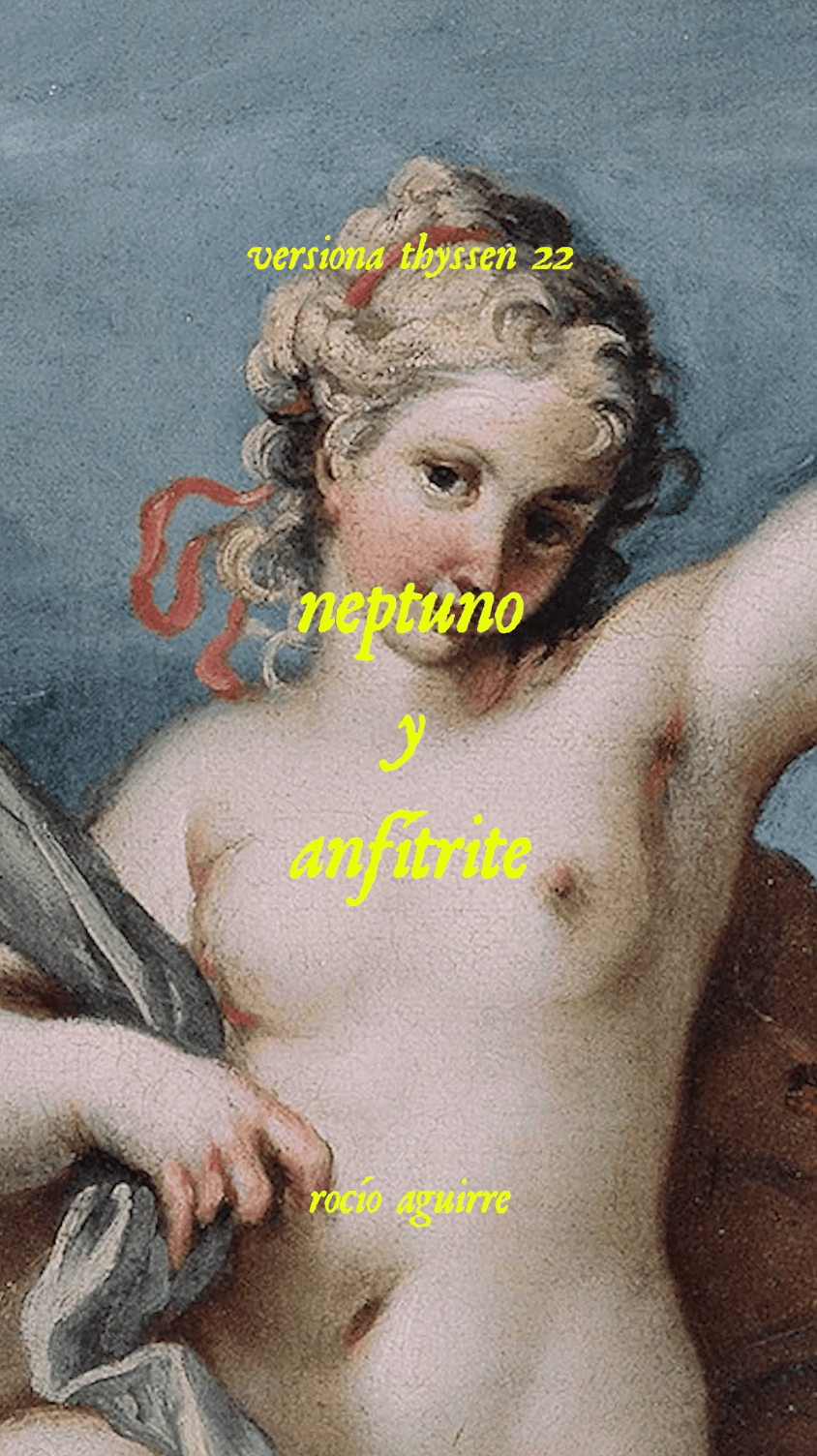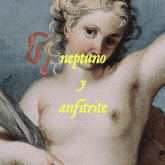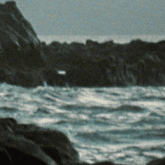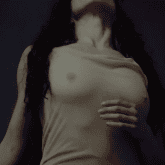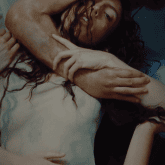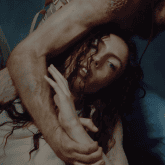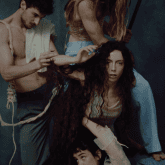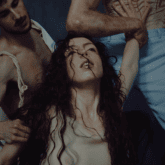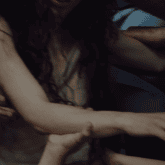In a short circuit between past and present, still image and moving body, Neptune and Amphitrite takes shape as a visual and sonic dialogue between Rocío Aguirre’s photography, Sebastiano Ricci’s 17th-century painting, and the cinematic gaze of Raquel San Nicolás. The project began as a commission from the Thyssen-Bornemisza Museum, which invited Aguirre to reinterpret a work from its collection, and evolved—through Raquel’s film—into a poetic reflection on desire, consent, and the representation of the feminine. Blending intimate references and radically simple choices, Raquel takes us behind the scenes of a work that blurs the lines between cinema, art, and choreography, allowing dense, suspended emotions to emerge—like a baroque dream.
NICOLE SALOTTI: How did the collaboration with the Thyssen Museum and photographer Rocío Aguirre come about?
RAQUEL SAN NICOLÁS: I met Rocío Aguirre a few years ago while working on a commercial project with an all-female technical and creative team. Since then, we’ve kept in touch—always following each other’s work and hoping for the chance to collaborate again. That opportunity came when the Thyssen Museum invited Rocío to reinterpret a painting from their collection through photography. She wanted to approach the process poetically and create a visual piece that would reflect that reinterpretation. That’s where I came in—Rocío reached out and asked if I’d like to create the film.
NS: The video is inspired by a 17th-century painting: Neptune and Amphitrite by Sebastiano Ricci. How was and what was the biggest challenge of stepping into this dialogue between photography and painting, translating a baroque artwork into a contemporary language?
RSN: The first and biggest challenge was definitely the budget. In my recent audiovisual projects, I’ve been lucky enough to have the resources to bring my references and ideas to life comfortably. But this time, it was a very small production—so I had to get creative and find a way to achieve the same quality without the usual tools and gear I’m used to. In a way, it became a really interesting exercise: embracing simplicity and proving (to myself, too) that you can create something evocative and visually rich just by pushing your imagination—and, above all, having a strong concept.
I directed, shot, and edited the whole thing myself, keeping the setup extremely minimal. The goal was to create something that had the emotional depth and composition of a painting using the simplest tool I had—my phone. We shot in a small studio, which added another layer of challenge considering Ricci’s painting is all swirling sea and drama. I leaned into that constraint by focusing on tight shots and highlighting the subtle movements of the dancers, the styling, and character work. Later, I layered in sound design and 16mm footage of the wild Tenerife sea I had shot earlier, to bring that maritime chaos into the piece.
Translating baroque through a contemporary lens was the real mission. I wanted to lean into poetry—emotional, slow, intense, and tender all at once. That contrast—painting vs. video—is what I was trying to capture. During post-production, Rocío asked me, “Do you think it’s too intense?” And I said, “We’re reimagining a baroque painting—it’s the perfect time to go full intensity.”
NS: The moving body plays a central role in the video so you worked with contemporary dancers. How did you choose them and what were you looking for in their body language?
RSN: The casting was Rocío’s choice. From the start, I imagined the video as something enigmatic and delicate—almost like the painting slowly coming to life. For movement direction, I aimed for slow, deliberate gestures that echoed and amplified the emotional states of each character. The choreography blended with the acting: Amphitrite caught in Neptune’s arms, surrounded by figures that lift and orbit her—living echoes of the story.
NS: The voiceover is Rocío Aguirre’s own. How did you build this poetic narration together? Did it come before or after the visuals?
RSN: The voiceover I did for a piece with C41 for Brunello Cucinelli was Rocío’s reference point. She wanted the voice in this piece to be her own—but rather than explaining the image-building process step by step, it was meant to be poetic and evocative, reflecting on the presence and roles of women in this reimagined work.
NS: The soundtrack plays a key role too. In what way did the music shape or respond to the choreography and movement on screen?
RSN: The soundtrack, Sea for the First Time by French composer Casual Melancholia, is from his 2019 album Global Warming. I’ve collaborated with him often—he has a rare sensitivity for blending classical delicacy with experimental edge. The song felt like a premonition, echoing Ricci’s narrative: Amphitrite, a nereid who initially rejects Neptune’s marriage proposal, is eventually persuaded by a group of dolphins. The music is fragile and deep, with a mysterious melancholy that, to me, captures the emotional tone of a woman being drawn in more than choosing freely.
NS: Your work reveals a very visual and almost poetic sensitivity. What guides you when directing? Who or what are your artistic or cinematic references?
RSN: What I value most is putting on screen what I struggle to express in words—simple things that move me, emotions not easy to articulate. I grew up in a rural village in the north of Tenerife, and that place shapes everything: from laundry swaying in the wind to the kitschy aesthetic of an old repair shop.
In terms of references:
– In painting, Suzanne Valadon’s portraits and Magritte’s dreamlike light and shadow.
– In cinema, Agnès Varda’s approach to reality, and the quietness and color sensitivity of Ozu and Rohmer.
– In photography, Saul Leiter and Alessandra Sanguinetti fascinate me.
NS: In your opinion, what role does video play today in narrating artworks? Can it become an extension, an interpretation, or even an autonomous piece?
RSN: Translating a work of art into movement is fascinating. The codes are different, but when two disciplines dialogue, they can enrich a shared concept. In this case, reinterpreting the painting allowed us to explore themes that still resonate today—desire, consent, societal roles, and emancipation from expectation.
Through a poetic and subtle lens, we give form to Amphitrite’s anguish—and open a space for reflection.
NS: If you could choose another classical artwork to reinterpret, which one would it be and why?
RSN: I’d choose something more contemporary: *The Blue Room* by Suzanne Valadon. It shows a woman lounging in loose clothes, smoking in privacy—not seducing, just existing. But that apparent simplicity hides a radical gesture: rejecting idealized portrayals of women. I’d love to tell the story of this calm, self-assured woman who quietly challenges the norm—wearing pajamas and completely unbothered.
